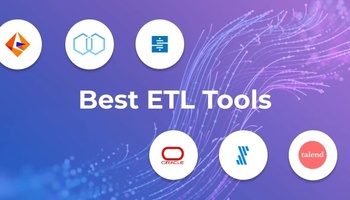Like peanut butter and jelly, ETL and data modeling are a winning combo.
- Data modeling analyzes data objects and figures out the relationships between them. It generates a theoretical representation of data objects — vendors or customers in SaaS databases — and how to store objects in a system, defining the rules for the relationship between tables.
- Extract, Transform, Load (ETL) applies these rules and checks them for anomalies. It makes sure data is ready for analysis. Then it loads this data into a data warehouse.
Data modeling can't exist without ETL, and ETL can't exist with data modeling. Not if you want to model data properly. Combining the two defines the rules for data transformations and preps data for big data analytics.
In the age of big data, businesses can learn more than ever about their customers, identify new product opportunities, and so on. However, for accurate data analysis, analysts should understand the relationship between pieces of information and how data flows in a system. Therefore, ETL data modeling is critical for data aggregation across disparate tools and platforms.
Integrate.io's no-code point-and-click ETL solution optimizes data modeling in your organization. Prepare data for the data warehouse of your choice and generate better analytics and data quality. Schedule a call to learn about Integrate.io's 14-day demo.
Why You Need ETL Data Modeling
The primary purpose of any data warehouse is to make it easy for analysts to query data and gather real-time insights for workflows. To achieve that, data should be reliable and accessible.
Data modeling takes care of the reliability part through the visual representation of information. It addresses entity integrity and referential integrity with the help of keys.
- Entity integrity refers to the reliability of data within an entity.
- Referential integrity refers to data reliability between entities.
Let's explore that with a simple example of two entities (or, in the world of data, "tables"): Vendors and products.
To maintain data integrity, each vendor and each product within their respective table has a unique ID. This provision is to avoid data duplication. Data modeling achieves that with the help of primary keys. To achieve data reliability between vendors and products, data modeling uses foreign keys, which are the primary keys of a table that exist in another table. In our example, the unique key for one vendor can identify the different products he makes.
Here, it is crucial to note the difference between 'transformations' of ETL and data modeling. The latter defines the rules for the relationship between tables. ETL applies those rules and checks for anomalies to ensure data is ready for analysis before being loaded into the data warehouse. This two-step process optimizes data transformation.
How ETL Data Modeling Can Drive Business Insights
The end-goal of a data warehouse is to facilitate business intelligence. Simply querying your sales figures year-on-year for a product will give you basic information about how your business is doing. However, if you can query sales figures against different demographics, or events, for instance, that is when things get interesting.
Doing so requires the aggregation of data. Transactional systems aren't the best at aggregation tasks. A transactional system, such as a CRM software or an ERP tool, records transactions or events like sales or page visits. The primary goal of transactional systems is data retention. These databases aren't suitable for data analysis.
Enter the world of dimensional modeling. Dimensional modeling uses two key concepts: fact tables and dimension tables.
- Fact tables store data that users need to analyze. This data is quantitative, such as sales, profits, or cost of goods.
- Dimension tables hold information on the various ways that users can analyze data in tables. It provides a descriptive context to facts in a system.
There are various approaches to dimensional data models, including OLAP and OLTP.
ETL data modeling, with the help of star schemas, builds bridges between facts and dimensions. Star schemas rely on a combination of dimensions to make different dimension tables. Any of these combinations should correspond to exactly one record in the fact table. Doing so achieves two goals:
- Avoiding data duplicity
- Expediting the process of aggregation and analysis
Modern data warehouses, though, are doing away with star schemas in favor of wide tables with many columns, which is explained in the next section.
Recommended Reading: ETL vs. ELT: 5 Critical Differences
Integrate.io simplifies ETL data modeling with low code and no-code solutions, streamlining data integration in your enterprise. Schedule a call and talk to a team member about Integrate.io's 14-day demo.
Best Practices for ETL Data Modeling
Any ETL data modeling should address the following concerns for data analysis:
- It should be possible to query data with simple joins
- The data structure should ensure uniqueness of data at all times
- A data model should allow granular querying of data by using periodic and accumulated snapshots of fact tables
Two key considerations form the basis for addressing those concerns:
1) Materialization
Materialization is the process of pre-aggregating data to improve query response times. Pre-aggregation is in contrast to a star schema that involves several tables. Pre-aggregating data reduces the number of tables and expands their width by increasing their number of columns. This method makes it easier for end-users to write queries, which addresses the challenge of simple joins.
In the real world, there is often a compromise between materialization and leaving some data unaggregated. As a general rule, any expensive joins in a system (in terms of response time) are suitable candidates for materialization.
2) Grains
The grain of a table or a view is what a single row in that table or view stands for. For instance, in a table named customers, the grain can be a single customer. Thus, each customer has a row on the table, and there is exactly one row per customer. That is a very simple example of grain in a data system.
Grains can get complex, though. Imagine a table named subscription_status where there is exactly one row per subscriber per status. Different statuses include: renewed, about to expire, and expired. Here, each subscriber has multiple rows associated with it, reflecting his subscription status.
Grains of a system decide how easy or difficult it is to combine tables and solve data analysis problems. For effective data modeling, it is important to first determine the grain of a table or a view and give it a distinct name.
The ETL Process Explained
Once data modeling defines the rules for the relationship between tables, ETL tools apply these rules and check them for irregularities. This process ensures the data is ready for a data warehouse and analytics.
An ETL system works like this:
- It extracts data from a pre-defined data source.
- It transforms the data into the correct format.
- It loads the data into a data warehouse like Snowflake, Amazon Redshift, Microsoft Azure SQL Database, or Oracle Autonomous Data Warehouse.
- (Or data lake.)
At this point, data is ready for analytics in a business intelligence (BI) tool. Then decision-makers, marketers, business analysts, and others can use the new data to expedite day-to-day workflows, generate real-time insights, and make predictions about business growth.
Recommended Reading: Top 5 Business Intelligence Platforms
Other processes might take place during ETL. These processes include data profiling, the process of evaluating source data, identifying its potential, and understanding its structure.
ETL involves many individuals, each responsible for specific tasks. These individuals include data engineers, data scientists, data architects, and others. Using an ETL platform can simplify the entire process. (More on this later.)
Challenges in ETL Data Modeling and a Solution
Conventionally, data modeling has dealt with building relational databases that involve structured data. However, the rise of big data has resulted in large amounts of unstructured data that users need to analyze. This unstructured data includes all sorts of machine data, such as data from IoT devices.
Modern data models have to contend with data repositories distributed across public cloud, private cloud, and on-premise architecture. Datasets are moving faster and getting more complex.
Data modeling algorithms are an effective way to tackle the challenge. Through the use of machine learning, statistical algorithms, and artificial intelligence, users can automate the process of data modeling. It does away with the time-consuming task of defining relations and data structures. Instead, users can focus on the business end of things: Using data to derive insights.
How Integrate.io Helps ETL Data Modeling
ETL data modeling poses many challenges for data-driven teams, but the biggest obstacle is probably coding. For ETL data modeling to work, data engineering teams need to build intricate data pipelines from scratch, and this process requires lots of programming. But what happens if organizations lack an engineering team or don't know code?
Integrate.io provides a solution. It's a no-code and low-code ETL platform with pre-built data transformations, making complex data preparation simple. Data pipelines that would otherwise take days, or even weeks, to build now take minutes. There's no need for a programming language like SQL or Java.
Another challenge with ETL data modeling is data validation. This challenge is a particular problem in the age of GDPR, HIPAA, and other data governance frameworks, where teams need to ensure data adheres with the relevant legislation — or face expensive penalties for non-compliance.
Integrate.io validates and transforms data before data warehousing, which improves compliance significantly. It also transforms data into a usable format, so it's compatible with the warehouse of your choice. Integrate.io makes it easy to validate data from various data sources and source systems such as metadata, SaaS data, CRM data, data warehouses, data lakes, and relational database management systems like Microsoft SQL Server.
In conclusion, ETL data modeling provides multiple benefits for data-driven teams, but the process is complex. Using a no-code and low-code solution like Integrate.io automates many of the tasks associated with data modeling, resulting in better analytics regardless of the data type.
Integrate.io's no-deployment point-and-click platform streamlines data modeling and the entire ETL process, creating big data pipelines in minutes. Schedule a call for more information about Integrate.io's 14-day demo.










